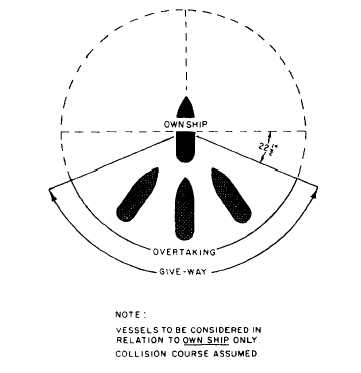| |
Overtaking Situation
Any vessel overtaking another must keep clear of
the overtaken vessel. An overtaking vessel is one that is
approaching another vessel from any direction more
than 22.5° abaft its beam (fig. 5-16). When in doubt,
assume you are overtaking and act accordingly.
GENERAL DEFINITIONS
Before we continue with our discussion of basic
rules of the road, you must first understand the terms we
will use. They are as follows:
Vessel includes every description of watercraft,
including nondisplacement craft and seaplanes used, or
capable of being used, as a means of transportation on
water.
Power-driven vessel means any vessel propelled by
machinery.
Sailing vessel means any vessel under sail, provided
that propelling machinery, if fitted, is not being used.
Give-way vessel refers to a power-driven vessel
underway having another vessel to starboard, thus
“giving-way” or allowing the other vessel to pass in an
overtaking situation.
Figure 5-16.–Overtaking situation.
Stand-on vessel refers to any power-driven vessel
in a crossing situation close enough to involve risk of
collision; the vessel having the other to starboard must
keep out of the way, or “stand-on,” not crossing ahead
of the other vessel.
Vessel engaged in fishing means any vessel fishing
with nets, lines, trawls, or other fishing apparatus that
restricts maneuverability, but does not include a vessel
fishing with trolling lines or other fishing apparatus that
does not restrict maneuverability.
Seaplane includes any aircraft designed to
maneuver on the water.
Vessel not under command means a vessel that,
through some exceptional circumstance, is unable to
maneuver as required by these rules and is, therefore,
unable to keep out of the way of another vessel.
Vessel restricted in its ability to maneuver means a
vessel that, from the nature of its work, is restricted in
its ability to maneuver as required by these rules and is,
therefore, unable to keep out of the way of another
vessel.
Vessel constrained by its draft means a power-
driven vessel that, because of its draft in relation to the
available depth of water, is severely restricted in its
ability to deviate from the course it is following
(International Rules only).
Underway means that a vessel is not at anchor, made
fast to the shore, or aground.
Length and breadth of a vessel mean its length
overall, and greatest beam or width.
In sight means vessels are deemed to be in sight of
one another only when one can be seen from the other.
Restricted visibility means any condition in which
visibility is restricted by fog, mist, falling snow, heavy
rainstorms, sandstorms, or any other similar causes.
Inland waters means the navigable waters of the
United States shoreward of the navigational
demarcation lines dividing the high seas from harbors,
rivers, and other such bodies of waters of the United
States, and the waters of the Great Lakes of the United
States' side of the international boundary.
Demarcation lines means the lines delineating those
waters upon which mariners must comply with the 72
COLREGS and those waters upon which mariners must
comply with the Inland Navigation Rules. (The
boundaries for the demarcation lines are listed in the
back of the Coast Guard publication Navigation Rules,
International-Inland.)
5-20
|

